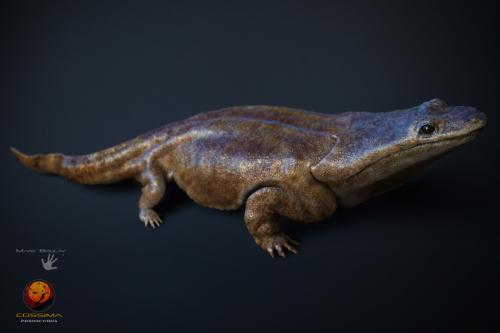A new find has surfaced from the depths of time in the annals of Earth’s history, where enormous reptiles and prehistoric mammals once roamed: Gaiasia jennyae. With its sharp fangs and impressive predatory skills, this enormous animal—which resembles a salamander but is larger than a human—has captivated the attention of scientists all over the world. Discovered from fossilized remains in Namibia, this extinct predator offers a window into a far-off past that existed before the extinction of the dinosaurs.
The discovery of the massive predator Gaiasia jennyae, which resembles a salamander, has recently aroused interest in the early evolution of tetrapods. These four-legged animals, which include birds, mammals, reptiles, and amphibians, are essential to the change from aquatic to terrestrial life. With a geological age of about 280 million years, Gaiasia provides insights into an era when the climate and landscapes of Earth were very different from what they are today.
Finding and Importance
The fossils of Gaiasia jennyae, found in Namibia’s Gai-As rock formation, show a nearly complete skeleton, including a partial skull and backbone. These fossils, which were gathered more than ten years ago and have just been examined, demonstrate the animal’s unusual adaptations and its function as the top predator in extinct aquatic environments. Gaiasia highlights the complexity of early tetrapod evolution beyond typical hot, equatorial regions. It is named in honor of the late paleontologist Jennifer Clack, who led research on tetrapod evolution.
Physical attributes and conduct
The Gaiasia jennyae is distinguished by its massive, approximately two feet (60 centimeters) long skull and its incredibly sharp, predatory teeth. Its wide, flat head and unique teeth may have been used for suction feeding, which allowed it to precisely catch and eat prey, according to paleontologists’ theories. Biologist Michael Coates metaphorically referred to this predatory tactic as “an aggressive stapler,” which illustrates Gaiasia’s adaptation to flourish in extinct aquatic environments brimming with life.
Evolutionary Perspectives and the Ecological Framework
Previous theories that early tetrapods were primarily found in hot, swampy areas have been called into question by the discovery of Gaiasia. The fossil record of Namibia, which was formerly colder and glaciated, points to a wider ecological range for tetrapod evolution. This poses important questions regarding the environmental circumstances that allowed them to diversify and disperse over continents in the late Paleozoic era.
Research Prospects and Scientific Consequences
Gaiasia jennyae research highlights how crucial it is to keep exploring Earth’s biological past in order to understand modern ecosystems. Understanding tetrapod origins and adaptations is improved by knowledge gained from fossils, which also illuminate the evolutionary routes that gave rise to a variety of terrestrial vertebrates. Subsequent investigations endeavor to clarify the genetic connections between Gaiasia, its function in prehistoric food webs, and the wider consequences of its finding on paleontological stories.

Gaiasia jennyae, in summary, reveals a powerful predator that once ruled prehistoric waters, serving as a testament to the richness of Earth’s history. Its discovery calls into question accepted knowledge regarding the evolution of early tetrapods and encourages more research into the intricate workings of extinct ecosystems. As paleontologists continue to uncover Earth’s mysteries, Gaiasia’s legacy offers profound insights into the evolution of life on land—a journey that began long before the dinosaurs roamed and continues to captivate the scientific community with each new fossil find.


















































































